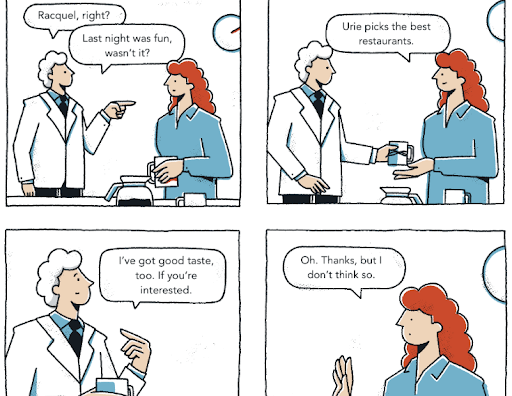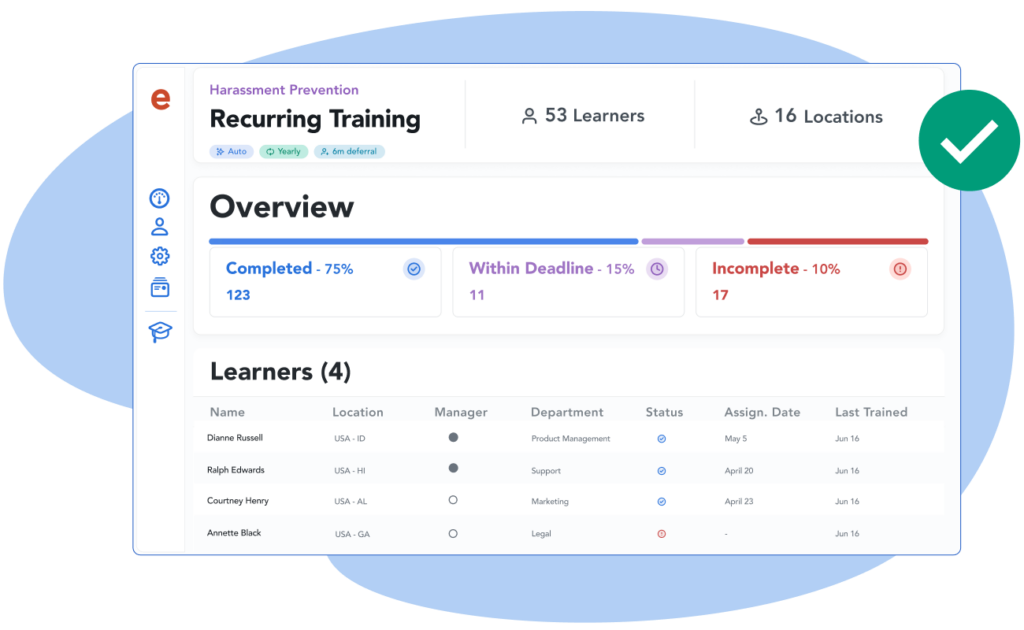Life is kind of like a game of Chutes and Ladders: there are challenging ascents and slippery falls, but despite the setbacks, all players are determined to keep scrambling to the Winner square. The same can be said in our workplace settings. As a team, we climb to new heights and occasionally tumble with setbacks. However, in the end, we want our work culture to continue on a path to the top.
One thing that can stand in the way of an organization’s ability to find the shortcut ladder to workplace cultural success is abusive behaviors in the workplace. No one wants to see the hard work (and strategic board game moves) that have been put into creating a healthy organizational culture go to waste. It’s a long slide back to Start when a workplace turns toxic, or even hostile.

HR and leadership teams need to be able to quickly determine instances of workplace abuse that contribute to a downward slippery slope. Knowing what are ways employees can be mistreated can help your team avoid the Chutes that could bring morale spiraling down in your workplace.
What is abusive conduct in the workplace
A workplace can be a high-stress, high-impact, and high-visibility environment. Quick deadlines, important clients, and fast turnover can make employees feel like a lobster dropped into a near-boiling pot. The stress that accompanies having a lot at stake (reputationally and financially) can bring out the very best or very worst in people.
In the US, there are laws at both the national and state level that determine what exactly is abusive conduct in the workplace. These laws protect employees from harm and undue stress from inappropriate, abusive, malicious, and humiliating behaviors. Under these laws, employees are protected from mistreatment by fellow employees, management, and customers on company premises.
For something to be considered abusive conduct in the workplace, one or more people must experience prolonged or persistent pressure or harmful actions in their physical or digital work environment. What can these work abuse situations look like? They’re past the levels of toxic and hostile work environments for starters, but let's zoom in to take a closer look.
6 abuse in the workplace examples
1. Harassment
Scenario. Tanya is preparing an important company-wide report, an assignment that she received after calling out the problems in the last report submitted by her coworker, Steve. She’s eager to take on the role but when she dives in she finds that all of the information needed to write the report is unexplainably “unavailable.” After many pitfalls, Tanya finally learns from another colleague that Steve has been sharing malicious gossip about her around the office and telling everyone on the floor not to help her with the report.
Harassment is potentially the top way that workers can be mistreated in an organization. And while harassment can take many forms in the workplace, all of them are dangerous. According to the U.S. Equal Employment Opportunity Commission (EEOC), retaliation is the most frequently-cited workplace claim (55.8%), followed by disability (36.1%), race (32.7%), and sex (31.7%). The EEOC also receives claims based on religion, age, national origin, color, and equal pay.
2. Unattainable performance standards
Scenario. It’s been two months since Diego’s supervisor put in his notice, at which point Diego was tasked with picking up the department slack. At the time he had been told this would only be “until the position was filled,” however, as the months go by, that office has remained ghost town-empty. Overworked and out of options, Diego is quickly reaching burnout. He asks the higher-ups for help, but their response? “It’s your work until it isn’t. If you don’t like it, you can leave. After all, this is your job.”
Unrealistic performance expectations have dire effects on employees, both mentally and physically. And this is another way that workers can be blatantly mistreated. Even those who are the best at setting boundaries can feel in over their heads when unemployment is dangled as a consequence.
3. Discrimination
Scenario. Georgia’s team was sweet enough to throw her a peachy pink office baby shower. But approve her parental leave? Well … they haven’t gotten back to her yet. As much as she appreciates the diaper gift cards and tiny baby shoes, obtaining that doctor-advised bed rest is what she really needs in order to eventually return to the office in one piece.
The Pregnancy Discrimination Act requires that employers provide reasonable accommodations for pregnant employees. It also outlaws discrimination on the basis of pregnancy, childbirth, or related medical conditions. So if Georgia's employers don’t take reasonable action to get Georgia off her feet soon, there could be legal repercussions.
When asked: “what are ways workers can be mistreated?” discrimination is a top top offender. In the US, workplace discrimination goes well beyond pregnant employees. It can be applied to a long list of protected classes, including:
- Age
- Sex
- Race
- Color
- Religion
- National origin
- Immigration status or citizenship
- Disability
- Veteran status
- And genetic information
From verbal abuse in the workplace (see: derogatory terms) to emotional abuse in the workplace, effective discrimination training can help remedy these forms of work abuse.
4. Bullying
Scenario. Tamil has been on the brunt end of the 2nd-floor clique ever since he started. Perhaps he wasn’t the right “culture fit,” or perhaps, his culture wasn’t one built to be inclusive of all. But every mistake made receives a magnified-glass investigation from his coworkers. To the point that now, whenever Tamil makes even a tiny mistake, his coworkers send a deluge of Slack messages his way saying, Can’t you go a day without ruining something?!
Bullying can range in severity from microaggressions to verbal abuse in the workplace. But regardless, it is a major way for workers to be mistreated. No matter the duration or intensity, bullying can lead to the same longstanding physical and mental effects as harassment or discrimination.
5. Abuse of power in the workplace
Scenario. Terry’s management style is known for leaving heaps of (metaphorical) eggshells that the whole team has to tiptoe around. Whenever even a little thing goes wrong, Terry’s boss flaunts his abusive power in the workplace by blowing up at whoever is unlucky enough to be nearby at the time. Terry and everyone else on her team are exhausted from feeling so on edge every 9 to 5.
Unhealthy workplace power dichotomies set the stage for many toxic workplace scenarios. What if this abuse of power situation involved sexual favors in return for a promotion? First, that’s quid pro quo, and illegal. And second, that serves as another example of abuse in the workplace.

So let’s set it straight. Abuse of power in the workplace sets the scene for scapegoating, emotional abuse in the workplace, and a myriad of other unhealthy complications in your organization. And when employees can’t even trust their management to protect their well-being, they’re quick to turn on the system rather than tolerate it.
(Shameless plug: Manager training is a skill to be learned, and we’ve made a bomb-diggity one that for a limited time, is free. Check it out and assign it to your managers today!)
6. Physical violence
Khan works in the office with Andrew. After Khan receives the promotion Andrew was certain would be his, Khan begins to notice some unsettling retaliative behavior. Andrew has begun to forcefully back up or “stumble” into Khan when they’re near each other in the break room or bathroom. At first, the threats seemed like jokes that had gone a step too far, but recently Andrew’s “accidental” assaults seem to be more and more aggressive.
The Federal Occupational Health and Safety Administration (OSHA) states that workplace violence encompasses any threat or act ranging from intimidation to homicide that occurs at the work site. Thankfully, there are warning signs, and preventative steps can be taken to deter escalation.
What are the legal ramifications of work abuse?
When it comes to the legal side of abuse in the workplace, both OSHA and the EEOC recommend that businesses adopt a zero-tolerance policy. OSHA also recommends having preventative and reporting systems in place for employees to know their rights and report incidents when they do happen. (Like an Employee Hotline tool.)
The legal ramifications for mistreatment in the workplace are serious. However, even if the law doesn’t get involved, the consequences of mistreatment can be felt around the workplace.
Perhaps Terry quietly responds to the verbal abuse by decreasing her performance output. Or Georgia gives up on waiting for management to take her health seriously and instead chooses to walk away for good. Of course, in any of these examples, if the employee does not receive legally required support, your business may just find itself being handed a hefty lawsuit.
How to fix abuse in the workplace
A proactive organization is one that is on the lookout for abusive behavior so that mistreatment never has a shot to grow. A responsible team knows that by the time harmful behavior (or the fallout from it) is visible, it is way past being fixed with just preventative measures. Thankfully, a toxic workplace doesn’t need to stay that way — there are steps teams can take to remedy them!
Leadership teams and management should be on the lookout in the workplace for high turnover and poor morale. Extra steps can also be taken to protect employees in customer-facing roles. Management shouldn’t shy away from taking a stand. In fact, employees are more likely to trust that management has their back when leadership isn’t afraid to expose abusive behavior at the start.
Curtail work abuse with Ethena
The fastest and most practical way to prevent your organization from abuse in the workplace is with appropriate, engaging corporate compliance training. Workplaces that prioritize ethical environments are healthier, happier, and retain talent longer. And an effective Harassment Prevention course can inspire learners to foster healthy, inclusive, and supportive work environments.

Ethena takes following legal requirements and safeguarding non-toxic workplaces even further with our evidence-based Harassment Prevention training. How has our course received a 95% approval rating from learners? By featuring cringe-free content that is made with the modern learner in mind.
We use modern, real-world scenarios so that every learner can see what workplace mistreatment looks like beyond the training manual. We know that helping learners witness those “Aha!” moments can keep “Uh oh” out of your legal team’s vocabulary.
Ethena takes easy compliance training beyond the learners to the teams that support them. That’s why we feature easy onboarding with common software integrations and a data-packed training dashboard so that you can see which employees are on track and which knowledge gaps need further work.
Ready to see Ethena’s Harassment Prevention training in action? Request a sample to see why Ethena has received over 1.2 million positive ratings from satisfied learners.
Want to learn more about how Ethena goes beyond check-the-box regulation requirements to inspire learners to build healthy, inclusive workplaces? Let’s talk.









